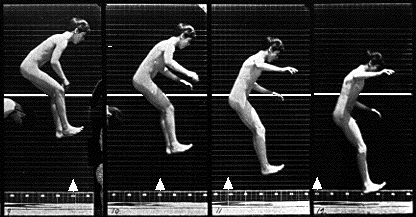
Fashioning the Body: Versions of the Citizen, the Self, and the Subject
The Evergreen State College | Fall 2007-Winter 2008
User Login |
Thoughts from "Latino Dolls"
Thoughts, Connections, Questions from Reading "Latino Dolls"
This is an ode… An ode to Chelsea where the light is bright grey-white by day and amber-colored at night. An ode to all the Barbie dolls I played with two summers ago. And an ode to the animator/filmmaker dearest to me. 1. What is a gay toy store? In the beginning pages of “Latino Dolls” I really wasn't sure what would constitute a gay toy store. Does Quiroga mean a sex shop? No? Does he mean something like Toys R Us except somehow more gay? No? It suddenly occurred to me that I knew exactly what was being described because I used to live in Chelsea (the sort of lower westside in Manhattan) which is the floral/photo/fashion part of town and not unrelatedly the rich, gay, white, male capital of the east coast. I could never find anything I wanted to buy in Chelsea. Every other store seemed to be a snobby, overpriced little den selling semi-whimsical printed tank tops, t-shirts, notecards, and endless snarky, queeny, brightly colored knickknacks. Here I am, three years later realizing that half my neighborhood was and is composed of gay toy stores. My limited (read: not important) gay consumer dollars go to buying all of those impossible-to-find-new Sarah Schulman books. Now… does that make me a less evolved consumer? 2. Would somebody save up (their money) to buy a gay doll? Yes! Fortunately and unfortunately. The 2000 $50 price of a Billy or Carlos doll was rather prohibitive, but not so much so that a few sacrifices wouldn't be made for a trendy, joyful, way to recreate a piece of childhood. This makes me think of the character David in Sarah Schulman's Rat Bohemia (which is the book of my life, my favorite book). David's childhood is marked by rather cruel parental enforcement of gender normativity -- no skipping, no singing, no giggling, no limp-wristed gestures. He's the type of kid always getting a football instead of the Barbie doll he might really want. In my mind that kind of childhood supersedes, overwhelms even a very clear understanding of the marketing schemes behind something like the Billy doll. You're buying something you couldn't have in childhood. You're trying to find a way to rename, reclaim, recapture something not possible in the past. It's awful, but how do you separate those feelings? (It's not possible to be completely separate from culture.) Working on gay guilt and pain is the best (worst) marketing plan ever. Someone I know who is a horrible reality TV junkie almost had me convinced to watch the show "The Amazing Race" because two of the contestants are a lesbian couple. I know that that show is horrible, that reality TV is what killed TV that I loved (like major network TV movies), and that despite having gay characters/contestants this show could not possibly say anything to me. And yet I was really excited about watching this show. There's a longing for working through or seeing your queerness in the world that sometimes manifests itself into buying things or watching shows that have a complicated, troubling consumer linkage. Consumerism -- it’s in that nasty entanglement with activism or pride or identity or something… 3. What could a gay doll look like? The gay doll is very much for the gay male consumer. There's just so much more earning power and expendable income, therefore so much more of the likelihood for something like a doll for gay men. I'm pretty sure people would not latch onto a lesbian doll in the same way as with a Billy doll or Earring Magic Ken. I guess my question then is what would a lesbian doll look like? Would it resemble that "famous" librarian and her action figure/doll that is spoken of by librarian-aspiring folks? I think a lesbian doll is much more likely to be an individually crafted alteration of an existing doll, such as the SM Barbies found in Barbie’s Queer Accessories and also Barbie Nation. Another image I have of what a lesbian doll could look like is the doll made (by an Evergreen student in the 90s) to resemble my best friend's mother (who taught at Evergreen until somewhat recently). Apparently, it's possible for a "regular" Barbie to be converted (or I'd like to think naturally age) into a spiky grey haired, glasses-wearing, notebook-carrying lesbian filmmaker. Now that's magic! And In brief... 4. Queer marketing has me thinking about Stagestruck: Theater, AIDS, and the Marketing of Gay America, once more, by my BFF Sarah Schulman. This book is important, brilliant, and deeply under read. 5. The Femme Book, which I will never stop writing or talking about, has the great piece "Passing Loqueria" which features ideas about boundaries (a very important theme for our cyborg weeks) around Latin race/nationality and queer sexuality. I will hopefully have that scanned and available for anyone who wants to read it. 6. Why does “Latino Dolls” not mention Earring Magic Ken? Just one sentence would have been sufficient. Maybe this topic is overdone, but I still love that Mattel accidentally created and sold a very gay doll that they had to pretend was not gay by claiming it was designed for girl children who love earrings and other ring-shaped things. 7. And to close, here is a link for the book Barbie's Queer Accessories by Erica Rand, which I am still in the middle of reading.
Submitted by christine on Thu, 11/29/2007 - 1:03pm. christine's blog | login or register to post comments | printer friendly version
|
Who's onlineThere are currently 0 users and 1 guest online.
Events
|
|||||||||||||||||||||||||||||||||||||||||||||||||